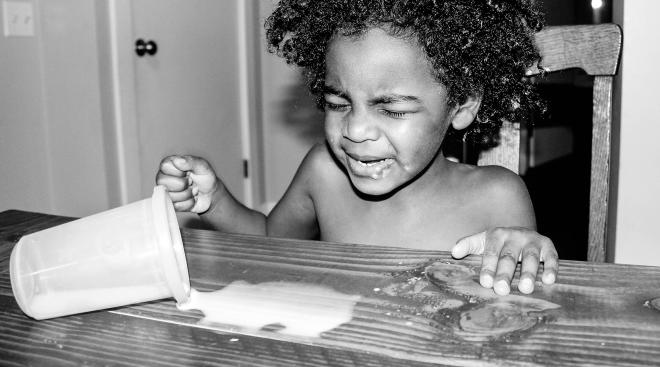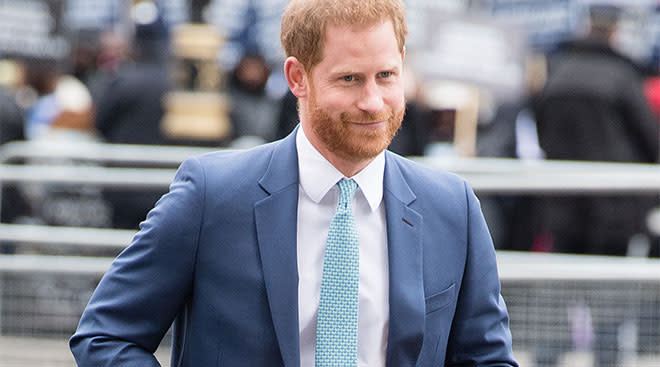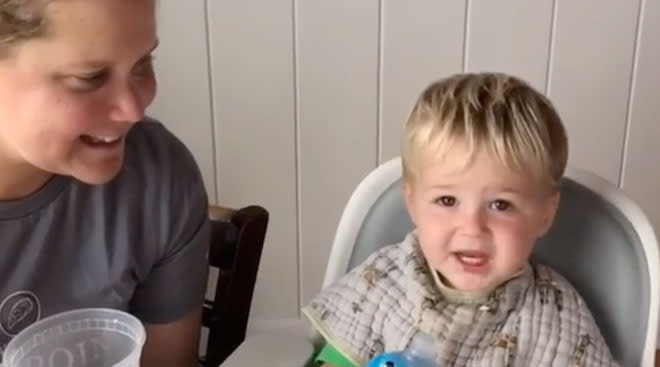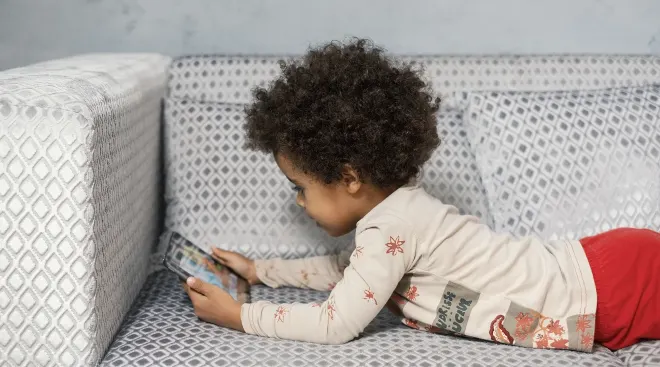When Do Babies Start Sitting Up?
Life with baby is filled with firsts—first bath, first yawn, first smile, first word. For new parents, it’s common to wonder, “when do babies sit up?” And what could be more exciting than finally watching baby sit up on their own, with those chubby legs sticking out, ready to make new discoveries? Baby sitting up by themselves is a major milestone that sets the stage for crawling, pulling up to a stand and walking. Before you know it, baby will be on the go! But first, when do babies start sitting up? Well, just like with other developmental milestones, the average age for babies to sit up on their own can vary. Here, experts weigh in on when you might expect to witness it, plus tips on how you can help baby hone this gross motor skill.
The average age for baby to start sitting up is around 4 months old. At this early stage, baby will likely use their arms to stay balanced, but be aware that if someone gently touches them—or there’s a slight breeze—baby might tip over, says pediatrician Laura Jana, MD. As for when babies sit up on their own, typically babies can sit up unassisted around 8 or 9 months. Younger babies around 6 months may also be able to sit up on their own but typically can’t do it for very long.
During those first attempts, baby’s balance won’t be developed, so they’ll likely wobble, need some extra help and may not stay upright for very long before getting tired. Plus, baby also likely won’t be able to do other things while seated—like leaning, reaching or grabbing for things—just yet. (This happens once baby has mastered sitting up and is closer to crawling.) Instead, baby will often use a “tripod” position where they have their arms on the floor in front for balance. “As babies master balance and build up the necessary muscle strength and endurance, they will become confident sitters, usually by 9 months,” Jana says. That said, know that there is a range for hitting developmental milestones, and baby will go at their own unique pace.
There are some key signs parents can look for to know if baby’s ready to start sitting up—including if they start lifting their head to look around. This usually means parents can start putting baby in a supported seated position, Jana says. The reason? Before baby can start sitting, they must first master holding their head up. Don’t forget—baby’s head is heavy and large in proportion to their little body, so it requires strong head and neck muscles. “Once baby has mastered holding their head up straight—not wobbly—and looking around, then sitting up is going to be next,” says Jean Moorjani, MD, FAAP, a pediatrician at the Arnold Palmer Hospital for Children in Orlando, Florida. Along with good head control, baby will also need to master rolling over—especially from back to front, which takes more coordination and torso strength.
Wondering how to teach baby to sit up? Luckily, there are lots of methods you can try out to help baby tackle this latest milestone. But to ensure baby’s safety as they begin to learn how to sit, make sure they’re on a flat surface with a soft place to land if they do fall over (like a bed or a pillow on the floor). And make sure there aren’t any choking hazards on the floor or safety concerns nearby, like uncovered outlets or hanging wires baby could pull on.
Practice tummy time
One of the best ways to teach baby to sit up is with tummy time. Set a soft blanket or mat down on a firm, flat surface, and place baby belly-down on top of it. Start small with about five minutes a day and then aim for around 20 to 30 minutes a day by the time baby is 3 or 4 months old. Moorjani suggests placing baby’s favorite toy just out of reach so they’re motivated to raise their head and reach their arms out to grab it. “This will help build those core muscles that are needed for holding the head up and sitting up,” Moorjani says.
Give baby a helping hand
Once baby is able to lift their head, if they’re lying on their back, try gently holding both of their hands and pulling them into a sitting position. “Babies like that—it’s fun for them,” Moorjani says. It also helps them get a feel for the motion that’s needed to go from lying down to sitting up. Just keep a close eye as you practice teaching baby to sit up—use caution to avoid baby toppling over and getting hurt.
Prop baby up
“Propping babies in a supported seating position can help start to strengthen muscles,” Jana says. A breastfeeding support pillow makes a great bolster. Or, you can try sitting on the floor with baby sitting upright on your lap or in between your legs. These will all help baby to feel more comfortable in a seated position. “At the same time it’s really important not to prop babies up for too long if they’re not developmentally ready, as it can be tiring and make baby cranky,” Jana adds. Similarly, avoid propping babies up in car seats or strollers because it doesn’t give them a chance to move, wiggle, reach and roll the way they can on a mat on the floor.
Consider using “sitting up toys”
Yes, there are toys designed to encourage baby sitting up. Jana recommends stationary play centers, such as ExerSaucers, because they provide 3- and 4-month-olds the support they need to start playing upright. Plus, there’s usually plenty to keep them engaged, from lights and sounds to pull toys. Or, to keep baby interested in staying upright, you may also want to try playing with interactive activity balls, cubes or colorful stacking toys. Again, just be mindful not to force baby to stay upright for longer than they’re ready.
You might have also seen infant floor seats or multi-stage booster seats that can help prop infants upright for playtime and mealtime. But be wary of using these products for an extended period of time. According to Nationwide Children’s Hospital, these seats could lead to container syndrome, which occurs when baby spends too much time in a device that limits their natural ability to move around. As a result, baby’s unable to activate important muscles for their motor development. If you do choose to use one of these seats, always consult with your pediatrician beforehand. Make sure the seat is low to the ground, closely supervise baby and limit how much time your little one spends in it.
It’s perfectly natural for babies to reach developmental milestones in their own time. “Don’t get too worried if another baby is doing something before your baby,” Moorjani says. If, however, baby doesn’t have good head control by 7 months, hasn’t mastered sitting unsupported by 9 months or if something just seems off, bring it up with your pediatrician. It may be nothing, but if there’s a developmental delay, you’ll want to catch it early so it can be addressed right away—especially since early intervention can make a significant difference when it comes to addressing developmental delays.
Once baby has learned to sit up unassisted, it’s time to childproof your home, because—guess what?—crawling is next on the list, typically between 6 and 10 months, followed by pulling up to stand and walking. (Both crawling and pulling to a stand require torso strength and coordination, so those skills progress organically once baby is a confident sitter.) That means in a very short time, anything within reach of baby’s curious hands is going to be grabbed, pulled, yanked—and also possibly put in baby’s mouth. There are many exciting milestones ahead, so go ahead and babyproof your home, grab your camera and enjoy all of these precious moments.
Please note: The Bump and the materials and information it contains are not intended to, and do not constitute, medical or other health advice or diagnosis and should not be used as such. You should always consult with a qualified physician or health professional about your specific circumstances.
Plus, more from The Bump:
Jean Moorjani, MD, FAAP, is a board-certified pediatrician at the Orlando Health Arnold Palmer Hospital for Children in Florida. She earned her medical degree from Virginia Commonwealth University School of Medicine and completed her residency at Orlando Health.
Laura Jana, MD, MD, is pediatrician and educator with over 20 years of experience. She’s the author of Heading Home with Your Newborn: From Birth to Reality, The Toddler Brain: Nurture the Skills Today That Will Shape Your Child’s Tomorrow and Jumping Into Kindergarten, as well as an associate research professor at Penn State’s Edna Bennett Pierce Prevention Research Center. Jana received her medical degree from Case Western Reserve University and completed her residency at the University of California San Francisco and Rainbow Babies & Children’s Hospital in Cleveland, Ohio.
Nationwide Children’s Hospital, Container Baby Syndrome: How Equipment Can Hinder a Child's Development, October 2018
Learn how we ensure the accuracy of our content through our editorial and medical review process.
Navigate forward to interact with the calendar and select a date. Press the question mark key to get the keyboard shortcuts for changing dates.




















































